When you’re trading with a 15-minute chart, the ups and downs in the Forex market can affect your ability to stick to your trading plan. You need a reliable moving average to help you understand the market’s direction in this lower time frame.
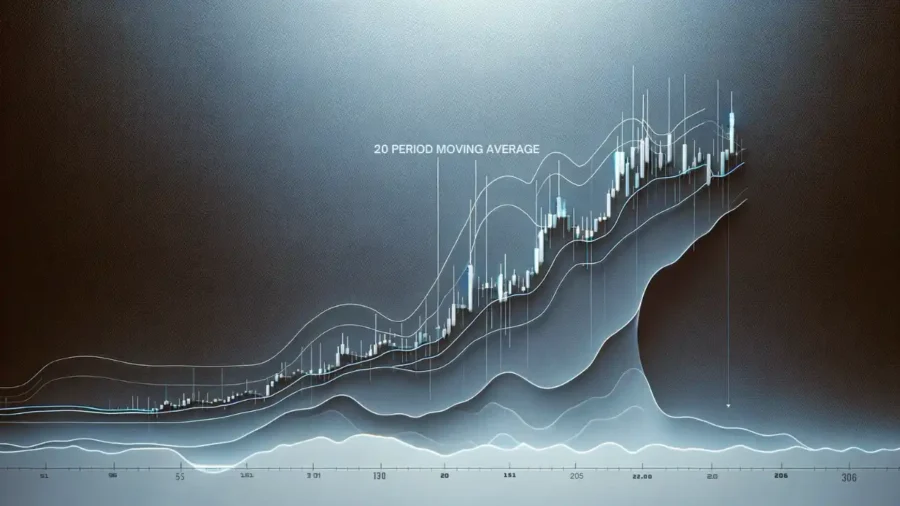
The 20-period exponential moving average (EMA) is a great choice. It adjusts quickly to price changes, which helps you make better decisions about when to buy or sell. Some traders prefer the 10-period EMA for faster signals, or the 50-period EMA for a wider overview, but the 20-period EMA strikes a good balance and is one I use on all my charts.
It’s important to pick the tool that works best with your trading approach, and the 20 EMA might be the perfect one to help you with quick, short-term trades.
Understanding Moving Averages In Forex
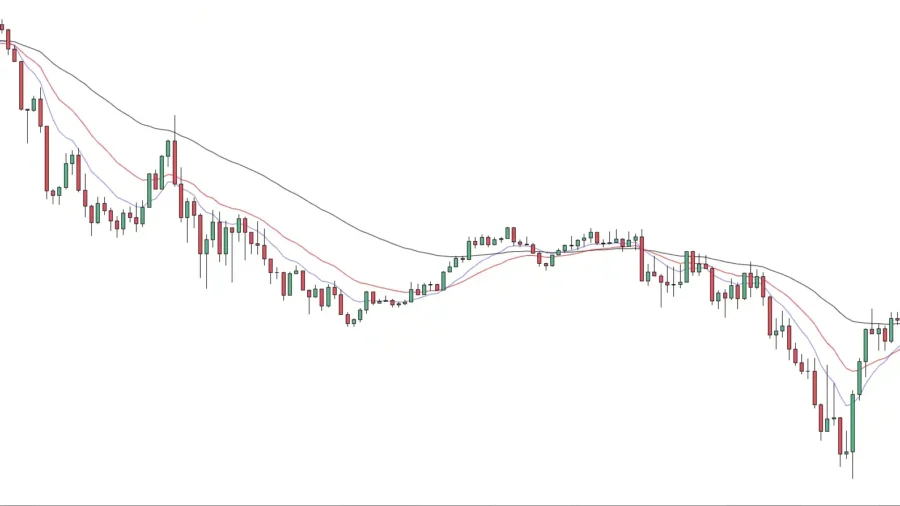
When you look at a 15-minute chart Forex chart, it’s important to know how a moving average makes the price data easier to read by turning it into one smooth line. This average line helps you see which way the price is going, up, down, or sideways.
You’ll find two kinds: the simple moving average (SMA) and the exponential moving average (EMA) to be the most popular. For this period, a lot of traders prefer using the 20-period EMA because it quickly shows recent price moves, which can be useful for catching trends but not too fast that you get many fakeouts. But don’t just accept that without checking; it’s a good idea to try different periods, like the 10-period or 50-period, to see which one works best with the way you trade.
It’s helpful to remember that moving averages are more effective when you use them with other indicators and when you manage your risks carefully.
Types of Moving Averages
When you look at a 15-minute chart to analyze market trends, you’ll come across several common types of moving averages.
- A simple moving average (SMA) is an easy-to-understand calculation where you add up the closing prices over a certain time and then divide by that time to get the average.
- An exponential moving average (EMA) focuses more on the latest prices, which means it reacts to market changes faster.
- The weighted moving average (WMA), lets you decide how much importance to give each price in your average, and
- The smoothed moving average (SMMA), helps to create a steadier picture of market trends.
Choosing the right moving average is important for your trading but remember, they all use the same data points. The difference is in the calculation of the average. For example, if you want to see how prices are moving right now in the EURUSD, the EMA might be useful because it’s quick to show recent trends.
However, your trading plan is the deciding factor for which moving average you should use as it should match the way you make trading decisions. I use EMA for averages like the 20 period and SMA for the larger periods – personal preference.
Reading the Moving Average
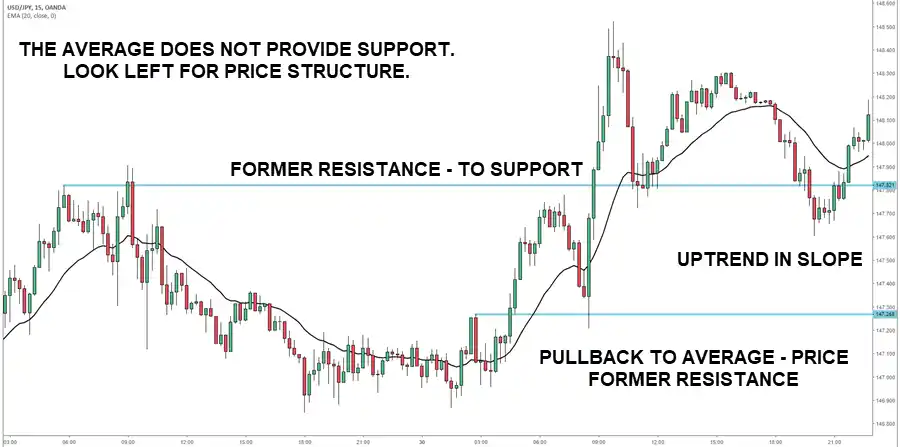
To understand the moving average on your 15-minute trading chart, watch for when the price crosses the 20-period Exponential Moving Average (EMA). This can show a possible shift in the trend.
- Look at the slope of the moving average to see if the trend is getting stronger or weaker.
- Notice how the price interacts with the 20 EMA, which can help you find levels where the price might stall or bounce.
- Combine the 20 EMA with other indicators to check and confirm what you’re seeing.
Using the 15-minute chart can give you quick information, but you should compare these findings with overall currency trends for better results. This way, you don’t rely on the moving average alone, but use it as part of a comprehensive trading approach which may include multiple time frames and price action.
Use the 20 EMA for a quick scan to quickly spot possible changes in trend direction. For instance, if you see the price of a stock repeatedly bouncing off the 20 EMA line, this could indicate that the zone is acting as support, suggesting the trend might continue upward. Dig deeper – look left and find the price cluster that is holding up the price.
If the price falls below the 20 EMA and can’t rise above it, the zone could be acting as resistance, hinting that the trend might be reversing or slowing down. This is where knowledge of price action and chart patterns can come in handy.
20 EMA Moving Average Strategies
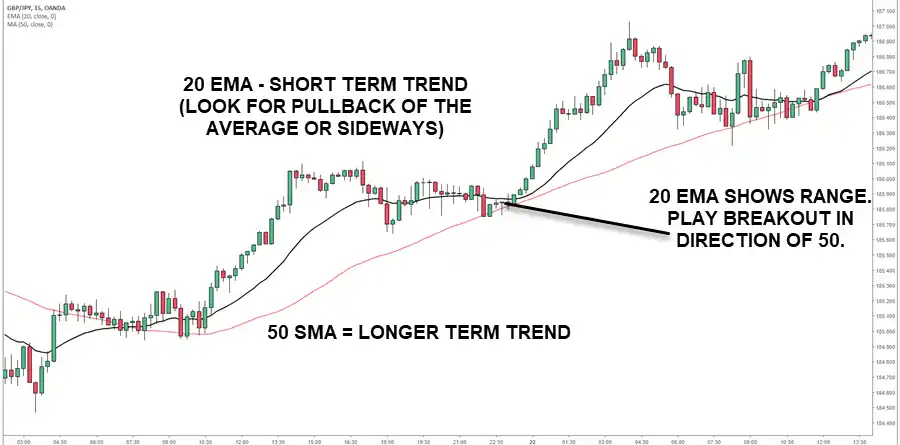
When you look at different strategies for using the 20 Exponential Moving Average (EMA), you’ll find that using more than one EMA on a chart that shows 15 minutes of trading can help you decide when to buy and sell.
Here’s a simple way to do it:
- Use a Mix of EMAs: Mix the 20-period EMA with both a shorter one (like the 10-period) and a longer one (such as the 50-period). This mix helps you spot various trends and gives you a clear picture of what’s happening with market momentum.
- Watch for EMA Crossovers: Pay attention to when one EMA crosses over another. If a short-period EMA goes above a long-period EMA, that suggests prices might go up; if it goes below, prices might drop.
- Make Changes When Needed: The great thing about EMAs is that they’re flexible. You can adjust them based on how much prices are changing or your trading approach.
Using these methods with a 15-minute chart can help you make sure that you’re using the EMA in the most effective way to make trades at the right times.
Tips for Moving Average Mastery
When using moving averages on a 15-minute FX chart, it’s important to know how different periods affect your trade signals. Short moving averages give you fast signals to enter or leave trades, which is useful for quick day trading decisions. But, they can also make the chart look cluttered and offer up conflicting signals which cause “analysis paralysis”.
Here’s an easy guide to help you tweak your strategy:
| Moving Average | Usage | Benefit |
| 10-period EMA | Fast trend spotting | Gives you trade signals quickly |
| 20-period EMA | Steady strategy | Works well for trends lasting a few days |
| 50-period SMA | Smooths out the data | Reduces clutter, shows clearer trends |
It’s important to remember that there isn’t a one-size-fits-all approach. You will have to change the length of the moving averages to suit how you trade. It’s always a good idea to test different settings to see what works best for your day trading methods.
Let’s break this down.
If you want to make a quick trade, a 10-period EMA might help you spot a trend early and act on it. If you’re holding a position for a couple of days, a 20-period EMA could give you a good balance by confirming trends without reacting to every market move.
For a broader view that filters out minor fluctuations, a 50-period EMA/SMA can show a strong trend that’s less affected by short-term changes.
To make the most of these moving averages, practice by looking at past data and see how these indicators would have performed. This backtesting helps you gain confidence in your strategy and make better decisions when real money is at stake.
Combining MAs With Other Indicators
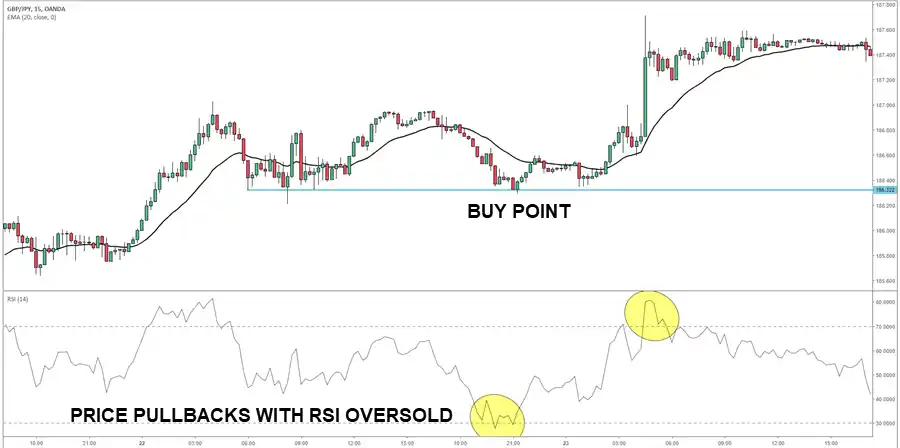
You should consider using moving averages with other technical analysis tools on your 15-minute chart to improve your trading methods.
Here’s how to pair them effectively with your favorite currency pairs:
- Bollinger Bands: These work well with moving averages. They help you see how unstable the market is and point out when prices might be too high or too low.
- Trend Lines: When you use trend lines with moving averages, it’s easier to understand if a market trend is strong and in which direction it’s moving.
- Relative Strength Index (RSI): Adding RSI to your moving averages can help you spot when the market might be changing direction by showing changes in momentum.
- Keltner Channel: Uses a 20-period EMA and is excellent at finding currency pairs that have “stretched too far” from an average price.
Frequently Asked Questions
Which Indicator Is Best for 15 Min Forex Chart?
For those using 15-minute charts, the 20-period exponential moving average (EMA) is a great tool. It’s good at showing short-term price movements, which can help you make trading decisions in line with the current trend. The 20-period EMA reacts quickly to price changes, which means it can provide timely information that you might use to decide when to buy or sell.
Which EMA Crossover Is Best for a 15-Min Chart?
If you’re looking for a good EMA (Exponential Moving Average) combination to use on a 15-minute chart, consider using the 9 EMA with the 20 EMA. This setup is often used by traders because it can help spot when a trend might be starting or changing direction quickly, and it can also provide good moments to enter a trade. It works well for short-term trading, where you need to make decisions fast. Remember, in a fast-moving market, being able to catch these moments early can make a big difference.
What Is the Best Moving Average for a Short Trend?
If you’re tracking short-term trends in the FX market, the 20-period exponential moving average (EMA) is a great tool to use. For example, if you notice that a currency price is consistently above the 20-period EMA, this might indicate an upward trend, suggesting it might be a good time to consider buying. On the other hand, if the price is below the EMA, it could signal a downward trend, and you might think about selling the base currency.
Conclusion
When you’re trading with the 15-minute chart, the 20-period Exponential Moving Average (EMA) can be a useful tool. Think of the 20 EMA as a guide that helps you read the market’s movements. It’s a line that can indicate when it might be a good time to buy or sell. The key is to use the 20 EMA along with your knowledge and skills. By doing this, you can make decisions that are in tune with the ups and downs of the market.
It’s not just about the indicator itself, but how effectively you use it to make trades. So, as you trade, let the 20 EMA help with your decisions, and you may find yourself making smarter, more profitable trades.
